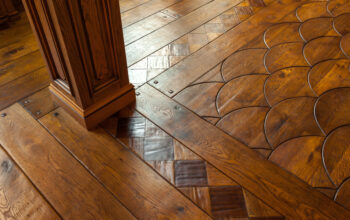Hardwood Floor Refinishing Bergen County NJ is a great way to breathe new life into old wood floors. However, there are some essential factors to consider before hiring a contractor.

One crucial consideration is addressing any water damage before refinishing. Another is choosing a stain color. Finally, there’s the decision to refinish or resurface the wood.
Hardwood floor refinishing is one of the best ways to add value to your home and make it look new again. However, it is a lengthy process that requires special equipment and time to complete. Refinishing your hardwood floors also creates a dusty environment, so you will want to take precautions to protect your furniture and other items in your home.
Before starting the refinishing process, it is important to determine what type of wood flooring you have. Wood flooring can be made from different types of trees, and each type has a unique grain pattern that will affect how it looks when finished. It is also important to distinguish between solid wood and engineered hardwood floors. While they both are made from hardwood, they are constructed differently and require different refinishing methods.
It is also important to identify any damage to your hardwood floors. Surface scratches, for example, can often be repaired by using a commercial scratch remover or by using an unshelled walnut and buffing the area with a soft cloth. If the scratches run deeper into the wood, they may need to be sanded down and re-coated.
Once the sanding process is complete, you can begin staining your hardwood floors. It is important to use a quality stain that is low in VOC (Volatile Organic Compounds). It should also have a tinting base that can be adjusted for color intensity. Once the stain is applied, let it dry for a day or two before applying a coat of varnish.
Once the final coat of varnish is applied, allow it to dry for a few days before moving your furniture and rugs back onto the floors. Once the finish has dried, it is recommended that you use a hardwood flooring cleaner to maintain the beauty of your floors. It is also important to have your hardwood floors buffed and recoated occasionally to prevent wear and tear. Keeping up with this maintenance will keep your floors looking beautiful and help them last longer. This will also prevent the need to refinish your floors in the future, saving you money in the long run.
Sanding
Hardwood floors look beautiful, but if they aren’t maintained properly over time, scratches, dullness and other problems can develop that can take away from their beauty. Refinishing is the process of removing old stain and applying a new finish to restore their original luster.
The first step in this process is sanding. This is a labor-intensive job, and it can take several days to complete the entire room. It is important to use a large drum sander and wear protective gear like gloves and a respirator to ensure the safety of yourself and others. The sanding process will remove the existing finish and expose the raw wood. It is also essential to follow the National Wood Flooring Association’s sanding guidelines for proper results.
Once the sanding is complete, it’s necessary to clean the floor thoroughly. Then, it’s ready to be stained and sealed. There are many different types of stain and varnish available, but it’s best to choose a product that is oil-based or low in VOC (volatile organic compound). It should also be clear so that you can see any imperfections in the wood.
When choosing a stain, it’s important to test it on an inconspicuous spot of the hardwood floor. This will help you determine how deep of a color you want to apply and whether the hue will match well with the rest of the room. It’s also a good idea to read the instructions on the finish tin carefully so that you understand how much to apply and what kind of sheen you want to achieve.
It is crucial to let the finish dry between coats, and it will need at least 12 hours between each coat. It is also a good idea to do a smell test before sealing the finish to make sure that it doesn’t have a strong chemical odor. Then, you can enjoy your newly refinished hardwood floors!
Staining
Once the floors are sanded and smooth, the staining process can begin. Staining your wood flooring can breathe new life into old or dull looking floors. It is important to choose the correct color stain for your home. The right stain will accentuate the grain of the hardwood, and can dramatically change the look of your home.
There are several considerations when choosing a color for your wood floor, and it is important to get expert input in order to make sure that you will be happy with the final result. The skill required to achieve the proper color is called ‘color matching’, and it is one of the most difficult skills in the flooring industry to master.
The staining process is similar to painting, except that the stain is rubbed into the wood rather than being rolled or brushed on. It is also a bit more time consuming, and the floors must be completely dry before the polyurethane finish can be applied.
Before applying any stain, it is important to test it out on a small section of the flooring. The wood can absorb only so much stain, and if the floor is saturated it will begin to ‘bleed back’ into the surface as the solvent evaporates. This can occur even if the initial stain sample matches the desired color.
There are two types of stains used for wood floors, oil-based and water-based. The best stains are low in VOC, and have a tinting base that allows for easy color blending. The choice between water-based and oil-based stain will come down to the level of gloss that you desire for your floor.
Once the stain has been brushed on, it must be allowed to dry for 24 hours before the polyurethane can be applied. If you want to add a glossier appearance, then the floor must be sanded between coats with fine grit sandpaper.
Once the floor is sanded, it is crucial to clean the area thoroughly in order to ensure that no dust has gotten trapped. This can be done by vacuuming with a commercial backpack vac or a shop vac, and then wiping the floor down with a rag and mineral spirits. It is also a good idea to wipe down the walls and trim in the room where the floor meets them.
Finishing
Once the floors have been sanded, it’s time to stain. Again, this is a process that can be messy and time consuming. The best way to do this is in a vacant room. It’s also a good idea to close the windows and doors. If you do this, it will reduce the odor of the polyurethane as it dries. It’s important to read the instructions on the finish tin and apply the stain according to its specifications. It’s also recommended to work in small sections of the floor at a time and always rub the stain in the direction of the grain.
There are two kinds of wood finishes to choose from: a simple sealer, which lets the natural color and grain shine through but doesn’t provide much protection, or a polyurethane coating that has a glossy sheen. Polyurethane is the most common and provides excellent protection for hardwood floors, although it needs to be reapplied every six to 12 months.
You can use a water-based or oil-based polyurethane. The difference is that oil-based polyurethane dries at a slower rate than water-based, so it gives you more time to touch up any mistakes. Water-based polyurethane, on the other hand, dries faster but may not provide as long of a life for your floors.
The amount of stain that you need to apply will vary, depending on the color of your floors and your desired level of opacity. Generally, it’s a good idea to apply three coats of polyurethane for the best results. Let each coat dry for a few hours before applying the next.

